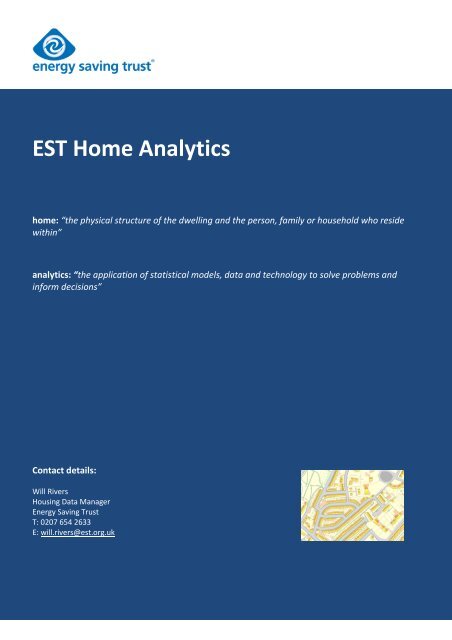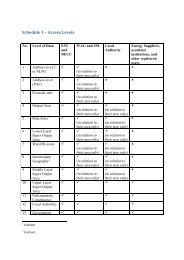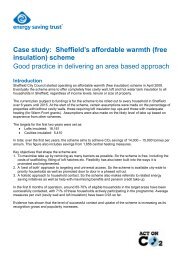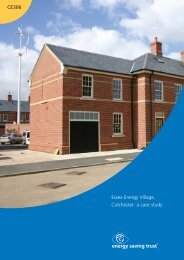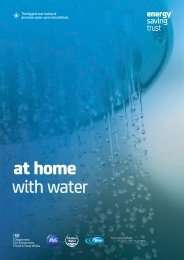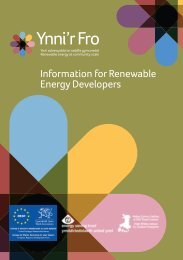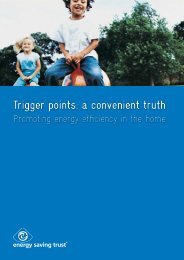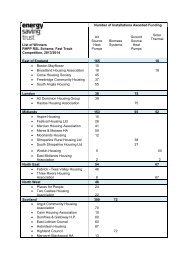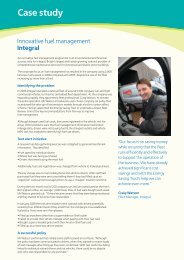EST Home Analytics - Energy Saving Trust
EST Home Analytics - Energy Saving Trust
EST Home Analytics - Energy Saving Trust
- No tags were found...
Create successful ePaper yourself
Turn your PDF publications into a flip-book with our unique Google optimized e-Paper software.
<strong>EST</strong> <strong>Home</strong> <strong>Analytics</strong><br />
home: “the physical structure of the dwelling and the person, family or household who reside<br />
within”<br />
analytics: “the application of statistical models, data and technology to solve problems and<br />
inform decisions”<br />
Contact details:<br />
Will Rivers<br />
Housing Data Manager<br />
<strong>Energy</strong> <strong>Saving</strong> <strong>Trust</strong><br />
T: 0207 654 2633<br />
E: will.rivers@est.org.uk
Understanding the market for low carbon retrofit<br />
The <strong>Energy</strong> <strong>Saving</strong> <strong>Trust</strong> has 20 years of experience targeting customers to deliver low carbon retrofit. During this time we<br />
have developed extensive datasets and a unique range of knowledge on the UK housing stock. We also have an in-depth<br />
insight in to UK householders, their attitudes to retrofit measures and how to target them effectively.<br />
To help other organisations target retrofit activity the <strong>Energy</strong> <strong>Saving</strong> <strong>Trust</strong> has develop <strong>EST</strong> <strong>Home</strong> <strong>Analytics</strong>.<br />
<strong>EST</strong> <strong>Home</strong> <strong>Analytics</strong> provides address level information on the UK housing stock, householders and the opportunities for low<br />
carbon retrofit. This data can be used to assess the size and location of opportunities for retrofit helping organisations to<br />
deliver measures through CERT, CESP, the Green Deal, Feed in Tariffs, the Renewable Heat Incentive and the open market.<br />
The data provided by <strong>EST</strong> <strong>Home</strong> <strong>Analytics</strong> seeks to answer the following questions;<br />
Which homes are suitable for which measures<br />
What is the overall potential for retrofit in an area<br />
<strong>Home</strong>s<br />
People<br />
Which householders are more likely to undertake retrofit<br />
Which householders are eligible for funding<br />
What marketing channels and messages will have the biggest impact<br />
The <strong>Energy</strong> <strong>Saving</strong> <strong>Trust</strong> is also the UK’s leading organisation providing robust information on the impact of measures:<br />
What are the costs, savings and payback periods<br />
How will different packages of measures affect different homes<br />
Improvements<br />
How will a retrofit scheme impact on the local economy and jobs<br />
Case Study: Targeting the<br />
Green Deal in Exeter<br />
The <strong>Energy</strong> <strong>Saving</strong> <strong>Trust</strong> worked with the Exeter<br />
Low Carbon Task Force to understand the<br />
potential for retrofit measures in the central<br />
Exeter housing stock. Wall type, loft insulation,<br />
glazing type, fuel type and boiler type were<br />
modelled alongside data on property tenure, age<br />
and type. As an additional step, SAP modelling<br />
was undertaken to understand the likely payback<br />
periods for Green Deal measures.
<strong>EST</strong> <strong>Home</strong> <strong>Analytics</strong> data variables<br />
Availability Dataset Scale Coverage<br />
Pack 1. <strong>Energy</strong> efficiency and property pack (all 10 datasets below)<br />
Now Cavity wall insulation / wall type Address Great Britain<br />
Now Loft insulation level<br />
Address Great Britain<br />
Now Glazing type<br />
Address Great Britain<br />
Now Gas mains present Y/N + off gas fuel type analysis<br />
Address United Kingdom<br />
Now Boiler type and age<br />
Address Great Britain<br />
Now Hard to fill cavities data<br />
Address Great Britain<br />
Now Property type<br />
Address United Kingdom<br />
Now Property age<br />
Address United Kingdom<br />
Now Property tenure<br />
Address United Kingdom<br />
Now Property size Address United Kingdom<br />
Renewable energy and fuel switching<br />
June 2012 Proximity to gas grid Address United Kingdom<br />
June 2012 Solar PV and thermal potentials data<br />
Address United Kingdom<br />
June 2012 Ground source heat pump potential (garden size and off gas)<br />
Address United Kingdom<br />
June 2012 Domestic wind potential<br />
Address United Kingdom<br />
June 2012 Distance to pavement (external wall insulation access)<br />
Address United Kingdom<br />
June 2012 Distance to nearest other dwelling (planning permission barrier)<br />
Address United Kingdom<br />
June 2012 Proximity to biomass supplier Address United Kingdom<br />
June 2012 m2 footprint of dwelling<br />
Address United Kingdom<br />
Funding eligibility and income<br />
June 2012 CERT PG and SPG eligibility Address Great Britain<br />
Now Experian household income<br />
Address United Kingdom<br />
Household energy use<br />
June 2012 Estimated energy use, CO 2 emissions and fuel bills Address Great Britain
Case Study – Targeting an external solid wall insulation programme<br />
In this case study, an organisation was interested in finding properties suitable for external wall insulation in the social<br />
housing sector. Dwellings suitable for external wall insulation tend to be solid walls that were built after 1919 so a<br />
combination of wall type, property tenure and property age datasets were used. The four maps below show the analysis<br />
results at address level for an example Lower Super output Area (LSOA). The map in the bottom right corner shows the<br />
combination of Social Housing, post 1920 solid wall properties that were likely to be the most suitable for the scheme.
Description of data variables<br />
<strong>Energy</strong> efficiency and property characteristics<br />
Cavity wall insulation<br />
/ wall type<br />
Over 4.5 million actual installations and survey records are used alongside modelled data to develop an<br />
estimate of likely wall type at the address level. Modelled data is derived from a combination of<br />
predictor variables (Property tenure, property type, property age, region, Index of Multiple Deprivation<br />
and rural/urbn morphology) and national housing surveys (the English Housing Survey, Scottish House<br />
Condition Survey and Living Wales survey).<br />
Output: Solid wall, Solid wall insulated, Cavity wall, Cavity wall insulated<br />
A factor between 0 and 1 is given showing the likelihood for each possible wall type<br />
Loft insulation level<br />
Over 4.4 million actual installations and survey records are used alongside modelled data to develop an<br />
estimate of loft insulation level at the address level. Modelled data is derived from a combination of<br />
predictor variables (Property tenure, property type, property age, region, Index of Multiple Deprivation<br />
and rural/urbn morphology) and national housing surveys (the English Housing Survey, Scottish House<br />
Condition Survey and Living Wales survey).<br />
Output: No loft, Loft insulation 0 – 50mm, Loft insulation 50 – 150mm, Loft insulation 150mm+<br />
A factor between 0 and 1 is given showing the likelihood for each possible loft insulation value<br />
Glazing type<br />
Over 7.3 million actual installations and survey records are used alongside modelled data to develop an<br />
estimate of glazing type at the address level. Modelled data is derived from a combination of predictor<br />
variables (Property tenure, property type, property age, region, Index of Multiple Deprivation and<br />
rural/urban morphology) and national housing surveys (the English Housing Survey, Scottish House<br />
Condition Survey and Living Wales survey).<br />
Output: Less than 80% Double Glazing, More than 80% Double Glazing<br />
A factor between 0 and 1 is given showing the likelihood for each glazing type<br />
Main fuel type<br />
Actual data on the presence of a gas meter at the address level forms the basis of the dataset. Where<br />
gas meters are no present modelled data on the fuel type for off gas dwellings is provided using a<br />
combination of actual and modelled data.<br />
Output: Main fuel gas, Main fuel electric, Main fuel oil, Main fuel communal, Main fuel solid<br />
The value of gas is given where a gas meter is present, a factor between 0 and 1 showing the likelihood<br />
for each fuel type is given where a gas type is not present<br />
Boiler type and age<br />
Over 2.5 million actual installations and survey records are used alongside modelled data to develop an<br />
estimate of glazing type at the address level. Modelled data is derived from a combination of predictor<br />
variables (Property tenure, property type, property age, region, Index of Multiple Deprivation and<br />
rural/urban morphology) and national housing surveys (the English Housing Survey, Scottish House<br />
Condition Survey and Living Wales survey).<br />
Output: No boiler, Standard boiler, Condensing boiler<br />
A factor between 0 and 1 is given showing the likelihood for each Boiler type
Hard to fill cavities<br />
data<br />
The <strong>Energy</strong> <strong>Saving</strong> <strong>Trust</strong> worked with Consultants Inbuilt to build on a previous 2010 DECC study on<br />
hard to fill cavity walls. The additional modelling we have undertaken provides a likelihood for<br />
individual addresses to be one of several hard to fill cavity types.<br />
Outputs: Narrow cavity, Concrete, metal or timber frame, Partial fill cavity, Too tall, Wall fault, Cavity<br />
with issues (non-CERT eligible, partial cavity, conservatory), Random stone<br />
A factor between 0 and 1 is given showing the likelihood for each hard to fill type<br />
Property type<br />
Property type data from Experian is used to provide an estimate of property type for every address in<br />
the UK.<br />
Outputs: Detached, Semi-detached, Bungalow, Terraced, Flat<br />
An absolute single value is provided indicating the modelled property type<br />
Property age<br />
Property age data from Experian is used to provide an estimate of property age for every address in the<br />
UK.<br />
Outputs: Pre 1870, 1871 – 1919, 1920 – 1945, 1946 – 1955, 1956 – 1979, Post 1980<br />
An absolute single value is provided indicating the modelled property age<br />
Property tenure<br />
Property tenure data from Experian is used to provide an estimate of property tenure for every address<br />
in the UK.<br />
Outputs: Owner occupied, Privately rented, Council/Housing Association<br />
An absolute single value is provided indicating the modelled property tenure<br />
Number of bedrooms<br />
Number of bedrooms data from Experian is used to provide an estimate of property size for every<br />
address in the UK.<br />
Renewable energy data<br />
Outputs: 1,2,3,4,5 bedrooms<br />
An absolute single value is provided indicating the modelled number of bedrooms<br />
Proximity to gas grid<br />
data<br />
The <strong>Energy</strong> <strong>Saving</strong> <strong>Trust</strong> can provide GIS modelled data on the proximity of every address to the<br />
nearest other gas meter. This provides a valuable dataset for identifying properties that are likely to be<br />
convertible to gas under the national grids standard connection charges.<br />
Outputs: Distance (meters) to the nearest gas meter.<br />
Solar potentials data<br />
The <strong>Energy</strong> <strong>Saving</strong> <strong>Trust</strong> has undertaken sophisticated GIS modelling of data available from the<br />
Ordnance Survey to ascertain likely roof orientation for every dwelling in the UK. Based on roof<br />
orientation and the degree of latitude of the property, we have calculated the solar PV and solar<br />
thermal potentials based on data held by the <strong>Energy</strong> <strong>Saving</strong> <strong>Trust</strong> of typical savings from solar, taking<br />
in to account usage patterns and export to the grid.<br />
Outputs: kWh Solar PV potential, kWh solar thermal potential, estimated kWh output (solar PV),<br />
estimated kWh output (solar thermal), estimated electricity bill savings (Solar PV), estimated fuel bill<br />
savings (solar thermal)
Ground source heat<br />
pump potential<br />
(garden size)<br />
(requires a licence<br />
for Ordnance Survey<br />
MasterMap)<br />
Domestic wind<br />
potential<br />
The <strong>Energy</strong> <strong>Saving</strong> <strong>Trust</strong> has undertaken sophisticated GIS modelling of Ordnance Survey’s Mastermap<br />
layer to ascertain garden size for every dwelling in the UK. Garden size is a key indicator of the<br />
potential for ground source heat pumps. This data can be combined with data on the presence of a gas<br />
meter and data on the m2 footprint of the dwelling to gain an accurate picture on the potential for<br />
ground source heat pumps.<br />
Outputs: Front garden size (m2), Rear Garden Size (m2), Total plot size (m2)<br />
The <strong>Energy</strong> <strong>Saving</strong> <strong>Trust</strong> has undertaken GIS analysis of the Met Office NOABL wind speed database<br />
and mapped average wind speeds for km2 grids to individual addresses. This data is combined on data<br />
with housing density in the surrounding area to provide an estimation of the dwelling’s suitability for a<br />
domestic wind turbine.<br />
Other variables<br />
m2 footprint of<br />
dwelling<br />
Distance to<br />
pavement (external<br />
wall insulation<br />
access)<br />
Distance to nearest<br />
other dwelling<br />
(planning permission<br />
barrier)<br />
Proximity to biomass<br />
supplier<br />
CERT Priority Group<br />
and Super Priority<br />
Group eligibility<br />
Experian household<br />
income<br />
The <strong>Energy</strong> <strong>Saving</strong> <strong>Trust</strong> has undertaken GIS analysis of Ordnance Survey data to ascertain an estimate<br />
of the m2 footprint of the dwelling. This information is particularly valuable for undertaking SAP<br />
modelling of properties or calculating the likely requirement for materials or size of a heating system.<br />
Outputs: building footprint (m2)<br />
Properties located immediately on the pavement can have access issues or potential planning<br />
considerations when installing external solid wall insulation or erecting scaffolding. The <strong>Energy</strong> <strong>Saving</strong><br />
<strong>Trust</strong> has undertaken GIS analysis to ascertain the distance of each dwelling to the pavement.<br />
Outputs: Distance to pavement (meters)<br />
Planning permission for many measures such as air source heat pumps can be dependent on the<br />
distance of the property to its nearest neighbour. The <strong>Energy</strong> <strong>Saving</strong> <strong>Trust</strong> has undertaken GIS analysis<br />
to determine both the nearest point and furthest point of a dwelling away from its neighbour.<br />
Outputs: Nearest distance to nearest dwelling (meters), Furthest distance to nearest dwelling (meters)<br />
The <strong>Energy</strong> <strong>Saving</strong> <strong>Trust</strong> can provide GIS modelled data on the proximity of every address to the<br />
nearest supplier of biomass fuel. Biomass suppliers and the types of fuel supplied are sourced from<br />
resources including the Biomass <strong>Energy</strong> Centre and the Logpile website.<br />
Output: Distance to nearest biomass supplied (miles) and the type of biomass fuel supplied<br />
The <strong>Energy</strong> <strong>Saving</strong> <strong>Trust</strong> has developed an model to predict the likely level of eligibility for the CERT<br />
Priority Group and the CERT Super Priority Group. The model is based on several datasets available to<br />
the <strong>Energy</strong> <strong>Saving</strong> <strong>Trust</strong> as well as data from the Office of National Statistics. The <strong>Energy</strong> <strong>Saving</strong> <strong>Trust</strong> is<br />
also working to predict the likely eligibility for the forthcoming <strong>Energy</strong> Companies Obligation (ECO).<br />
Output: CERT Priority Group eligible, CERT Super Priority Group eligible<br />
A factor between 0 and 1 is given showing the likelihood for each possible wall type<br />
Experian provide income projections for households which can be used to indicate people’s likely<br />
ability and willingness to pay for retrofit measures.<br />
Estimated energy<br />
use, CO2 emissions<br />
and fuel bills<br />
Based on the likely property and energy efficiency characteristics of the dwelling, the <strong>Energy</strong> <strong>Saving</strong><br />
<strong>Trust</strong> can model the likely energy use, CO 2 emissions and fuel bills of properties using SAP based<br />
software.<br />
Outputs: Estimated kWh energy use, fuel bills and tCO 2
Incorporating your data in to the analysis<br />
Where organisations have collected data on their housing stock, we strongly encourage that this data is included in the<br />
analysis to improve the accuracy of the model and the final dataset. The <strong>Energy</strong> <strong>Saving</strong> <strong>Trust</strong> carried out analysis for<br />
Newcastle City Council that incorporated the Council’s data. This was used to support the business case for a green finance<br />
retrofit scheme and will help to target priority areas for intervention. The <strong>Energy</strong> <strong>Saving</strong> <strong>Trust</strong> can provide a range of data<br />
processing analysis and presentation tools to provide a full database management, update and analysis service. Please<br />
contact us for further details.<br />
A holistic approach to targeting - the House,<br />
householder and suitability for measures<br />
To understand the market for retrofit a combination of data is required. For example,<br />
understanding the market for solar PV requires data on:<br />
Roof orientation<br />
Whether the dwelling could achieve a ‘D’ rating on an EPC<br />
The attitudes of the householder towards green retrofit and their ability to<br />
pay<br />
Example data input: <strong>Energy</strong> <strong>Saving</strong> <strong>Trust</strong> trigger points research<br />
The <strong>Energy</strong> <strong>Saving</strong> <strong>Trust</strong> recently undertook extensive<br />
market research to understand a) what type of people are<br />
most likely to undertake refurbishment activity b) at what<br />
life stage do they undertake retrofit c) what energy saving<br />
measures they would consider as part of the project and d)<br />
how much would they extend their budgets to incorporate<br />
green retrofit measures.<br />
This analysis can be mapped to Experian’s consumer<br />
segmentation analysis to enhance understanding of which<br />
households are the best potential customers for green<br />
retrofit.<br />
Example output: Regional level<br />
Greater London Authority – RE:NEW programme<br />
targeting<br />
The RE:NEW programme is London’s flagship programme for<br />
reducing CO 2 emissions from domestic properties. In order to<br />
target the scheme effectively, the GLA commissioned the <strong>Energy</strong><br />
<strong>Saving</strong> <strong>Trust</strong> to develop Ward level estimates of the remaining<br />
potential for energy efficiency measures. This data will be used<br />
to prioritise wards for door knocking and community<br />
engagement.
Further information<br />
For further information please contact<br />
Will Rivers<br />
Housing Data Manager<br />
<strong>Energy</strong> <strong>Saving</strong> <strong>Trust</strong><br />
e: will.rivers@est.org.uk<br />
p: 0207 654 2633
<strong>Energy</strong> <strong>Saving</strong> <strong>Trust</strong>, 21 Dartmouth Street, London SW1H 9BP<br />
Tel: 0207 222 0101<br />
energysavingtrust.org.uk<br />
XXXXX © 2010. <strong>Energy</strong> <strong>Saving</strong> <strong>Trust</strong>. E&OE<br />
This publication (including any drawings forming part of it) is intended for general guidance only and not as a substitute for<br />
the application of professional expertise. Any figures used are indicative only. The <strong>Energy</strong> <strong>Saving</strong> <strong>Trust</strong> gives no guarantee<br />
as to reduction of carbon emissions, energy savings or otherwise. Anyone using this publication (including any drawings<br />
forming part of it) must make their own assessment of the suitability of its content (whether for their own purposes or those<br />
of any client or customer), and the <strong>Energy</strong> <strong>Saving</strong> <strong>Trust</strong> cannot accept responsibility for any loss, damage or other liability<br />
resulting from such use.


